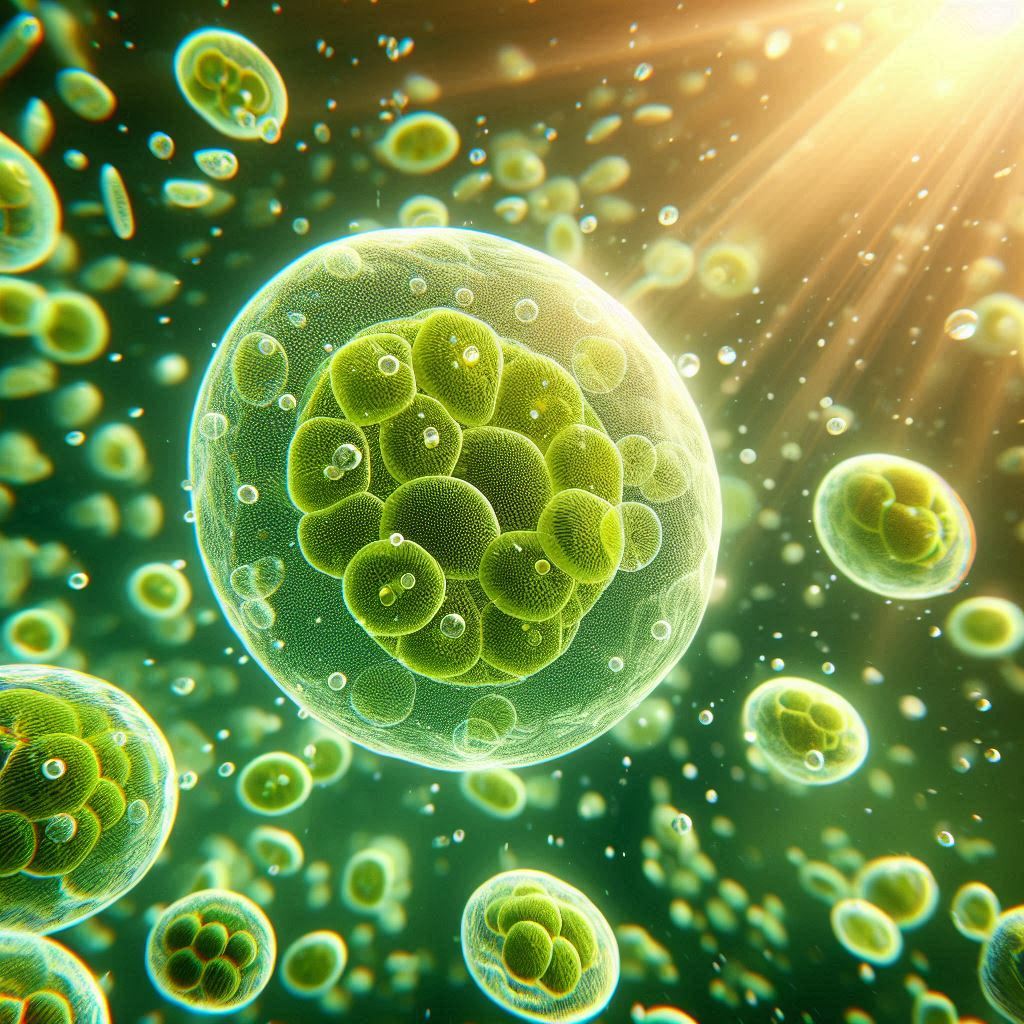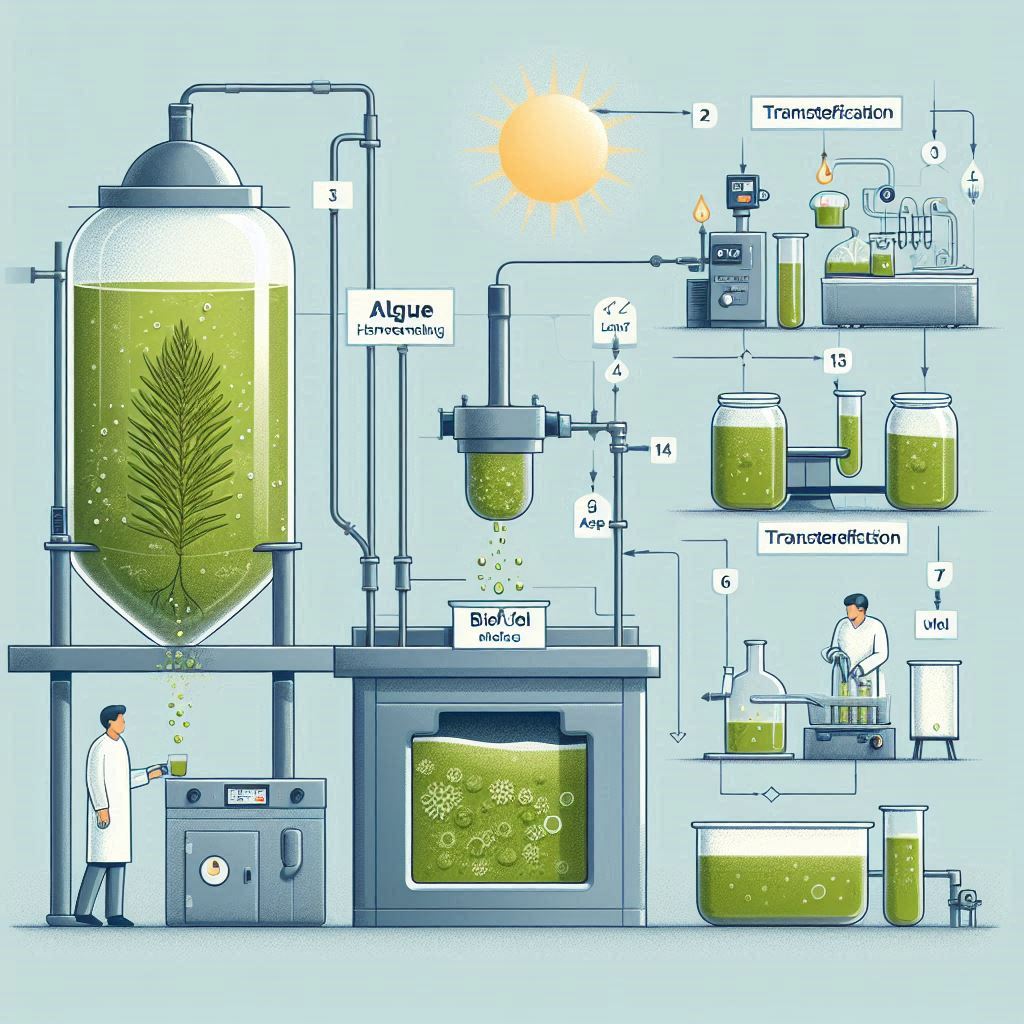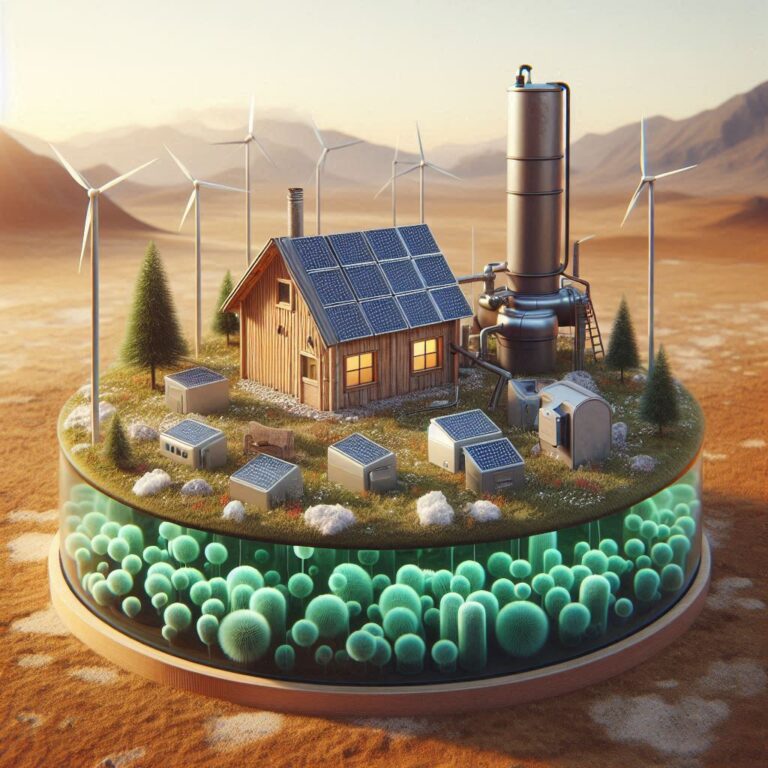Introduction: Algae-Powered Lamps and Their Potential
The quest for sustainable and eco-friendly solutions has led to a remarkable innovation: algae-powered lamps. While the concept of using algae for lighting might sound futuristic, it is rapidly becoming a viable technology with the potential to transform the way we illuminate our surroundings. Discover how algae lamps provide green energy lighting and CO₂ absorption benefits for eco-conscious consumers.

As we explore the exciting realm of algae-powered lamps, you’ll uncover how this innovative technology works and why it holds promise for the future. These lamps harness the natural process of photosynthesis, converting sunlight and CO₂ into clean energy and light. With their ability to thrive in diverse environments—from sunny urban landscapes to CO₂-rich underground spaces—algae lamps are not only reducing our carbon footprint but also offering a glimpse into a sustainable future. Join us as we delve into the science behind algae lamps, their real-world applications, and how they compare to traditional renewable energy sources. This journey will reveal how a small organism could play a big role in revolutionizing the way we think about and use energy.
Understanding Algae-Powered Lamps
The Science of Algae and Photosynthesis
Algae are diverse microorganisms that thrive in various aquatic environments, from ponds and lakes to oceans. They play a crucial role in the ecosystem by producing oxygen through photosynthesis, a process where sunlight is used to convert carbon dioxide (CO2) and water into glucose and oxygen. This natural process not only supports aquatic life but also helps in regulating atmospheric CO2 levels.
The key to algae-powered lamps lies in harnessing this photosynthetic ability. The lamps use microalgae, which are single-celled organisms with high photosynthetic efficiency. These microalgae are cultivated in a water-based medium within the lamp. When exposed to sunlight, the algae photosynthesize, producing energy that can be converted into electrical power.
How Algae-Powered Lamps Work
Energy Conversion Process
The algae-powered lamps operate on a two-pronged approach: photosynthesis for energy production and storage, and electricity generation.
- Photosynthesis: Algae in the lamp’s chamber use sunlight to perform photosynthesis, converting CO2 and water into glucose and oxygen. This process generates chemical energy stored in the algae.
- Energy Storage: The chemical energy produced by algae is captured using electrodes. These electrodes are embedded in the lamp’s water chamber and are designed to capture the excited electrons generated during photosynthesis. The captured electrons are stored in a battery.
- Electricity Generation: The stored energy in the battery is used to power the lamp’s light source. This means that the lamp can provide illumination even during the night or in low-light conditions.
- Alternative Energy Source: Interestingly, algae-powered lamps can also produce energy from CO2 without sunlight. This is achieved through metabolic processes within the algae that allow them to generate power even in dark environments, such as underground parking garages.
Different Methods of Producing Light and Energy Using Algae
Algae-powered lamps leverage various methods to convert the natural processes of algae into usable light and energy. Each method has its own mechanisms and applications, contributing to the overall efficiency and functionality of the lamps. Here’s an expanded look at the different methods used:
Photosynthesis-Based Energy Production
Photosynthesis is the primary process through which algae convert sunlight into chemical energy. In this method:
- Sunlight Absorption: Algae contain chlorophyll, a pigment that absorbs sunlight. During the day, chlorophyll captures photons from sunlight, initiating the photosynthesis process.
- Chemical Reactions: The absorbed sunlight excites electrons in the chlorophyll molecules, leading to a series of chemical reactions. This process converts carbon dioxide (CO₂) and water (H₂O) into glucose (a form of sugar) and oxygen (O₂).
- Energy Storage: The chemical energy produced in the form of glucose is captured and stored within the algae. In algae-powered lamps, this chemical energy is harnessed using electrodes placed in the algae’s water chamber. These electrodes extract the excited electrons and convert them into electrical energy.
- Battery Storage: The electrical energy is stored in a battery integrated into the lamp. This stored energy is then used to power the lamp’s light source during the night or in low-light conditions.

Applications: Photosynthesis-based energy production is ideal for environments with consistent sunlight, such as outdoor installations and sunny indoor spaces. It is a straightforward and efficient method for generating electricity from algae.
Electrochemical Energy Conversion
Electrochemical energy conversion involves capturing and converting the excited electrons produced during photosynthesis into electrical energy:
- Electrode Placement: Electrodes are strategically placed within the algae’s water chamber. These electrodes are designed to interact with the algae’s photosynthetic process.
- Electron Capture: As algae photosynthesize, they produce excited electrons. The electrodes capture these electrons through an electrochemical reaction.
- Electricity Generation: The captured electrons are used to generate an electric current. This current is directed into a battery where it is stored for later use.
- Energy Storage: The battery stores the electrical energy, which powers the lamp’s light source. This method allows for the conversion of chemical energy produced by algae into usable electrical energy efficiently.
Applications: Electrochemical energy conversion is particularly useful in designs where precise control over energy capture and conversion is needed. It is suitable for both small-scale and large-scale algae-powered lamp systems.
Biofuel Production
Biofuel production adds an extra layer of sustainability to algae-powered lamps by utilizing waste algae:
- Harvesting Algae: Once the algae in the lamp have reached the end of their lifecycle or need to be replaced, they are harvested. This process involves removing the algae from the lamp’s chamber.
- Processing into Biofuels: The harvested algae are then processed into biofuels through various methods such as fermentation or transesterification. These biofuels can be used as an alternative energy source for various applications.
- Sustainability Benefits: Utilizing algae waste for biofuel production reduces waste and contributes to a circular economy. The biofuels produced can offset the energy costs associated with maintaining and operating the algae lamps.

Applications: Biofuel production is valuable for enhancing the overall sustainability of algae-powered systems. It is particularly beneficial in scenarios where algae need to be regularly replaced, adding value to the waste material.
CO₂ Absorption and Energy Generation
CO₂ absorption is a unique method where algae lamps operate efficiently even in CO₂-rich environments:
- CO₂ Utilization: Algae have a natural ability to absorb CO₂ from the air. This capability is harnessed in algae-powered lamps to enhance algae growth and energy production.
- Enhanced Growth: High levels of CO₂ can stimulate algae growth, leading to increased photosynthetic activity. This results in higher energy production and improved efficiency of the lamp.
- Energy Generation Without Sunlight: In certain designs, algae lamps can generate energy even in the absence of sunlight by utilizing CO₂. This process involves metabolic pathways within the algae that allow them to continue producing energy.
Applications: CO₂ absorption is ideal for environments with high levels of CO₂, such as underground parking garages, industrial areas, or urban settings with elevated CO₂ concentrations. It ensures that algae lamps remain functional and efficient even in less-than-ideal lighting conditions.
Hybrid Systems
Hybrid systems combine multiple methods to optimize the performance of algae-powered lamps:
- Combining Photosynthesis and CO₂ Absorption: Hybrid systems integrate photosynthesis-based energy production with CO₂ absorption methods. This combination allows for continuous energy generation, even in variable environmental conditions.
- Enhanced Efficiency: By utilizing both sunlight and CO₂, hybrid systems can achieve higher energy efficiency. This approach leverages the strengths of each method to ensure consistent performance.
- Versatile Applications: Hybrid systems can be adapted for various environments, including those with fluctuating light conditions or high CO₂ levels. They provide a flexible and robust solution for diverse lighting needs.
Applications: Hybrid systems are particularly useful for applications where environmental conditions may change or where optimizing energy efficiency is crucial. They offer a reliable solution for both indoor and outdoor installations.
Explore further-
Current Innovations in Algae-Powered Lighting
Description of Existing Algae-Powered Lamp Prototypes and Their Real-World Applications
Pierre Calleja’s Prototype Lamp
French biochemist Pierre Calleja has made significant strides in algae-powered lighting technology. His prototype lamp utilizes microalgae to both produce light and absorb CO₂. The lamp features a transparent tube filled with microalgae-infused water and incorporates a battery system to store the energy produced. During the day, the algae perform photosynthesis, generating energy that charges the battery. This stored energy is then used to power the lamp at night. Calleja’s design is particularly notable for its potential application in CO₂-rich environments, such as underground parking garages, where it can function effectively even in low-light conditions.

Experimental Designs and Their Features
Various experimental designs of algae-powered lamps have been explored, each with unique features and applications:
- Green Glow Lamps: These lamps use transparent chambers filled with algae, producing a greenish light as it passes through the algae. They are ideal for decorative and ambient lighting.
- White Light Lamps: In these designs, algae are housed separately from the light fixture in a glass case above the lamp. This setup results in a white light output, suitable for general illumination.
- Street Lamps: Larger-scale street lamps incorporate algae throughout the fixture. They feature openings that allow CO₂ to enter and sunlight to reach the algae, providing street lighting while absorbing CO₂ from the environment.
Comparing Algae-Powered Lamps with Other Renewable Technologies
Efficiency and Effectiveness
When comparing algae-powered lamps with other renewable energy sources such as solar and wind power, several factors come into play:
- Energy Efficiency: Algae-powered lamps rely on photosynthesis, which has a lower energy conversion efficiency compared to solar panels. Solar panels can convert up to 20% of sunlight into electricity, whereas algae photosynthesis typically converts less energy.
- Environmental Impact: Unlike solar and wind technologies, algae lamps provide the additional benefit of CO₂ absorption. A single algae lamp can absorb up to 1 ton of CO₂ per year, equivalent to the CO₂ absorption of a mature tree over its lifetime.
- Cost: The initial cost of algae-powered lamps is higher due to the technology and cultivation requirements. However, their ability to reduce CO₂ emissions and provide eco-friendly lighting can offset these costs over time.
Economic Feasibility
The cost of algae-powered lamps includes several components:
- Production Costs: Cultivating microalgae and integrating them into lamp designs involve significant research and development costs. The materials used for the lamp’s construction, such as specialized glass and electrodes, also add to the expense.
- Installation Costs: Installing algae-powered lamps requires careful planning, especially for large-scale applications such as street lighting. The infrastructure needed to support the lamps, including CO₂ supply systems and maintenance access, can increase installation costs.
- Maintenance Costs: Regular maintenance is required to ensure the algae remain healthy and the lamp functions properly. This includes cleaning the glass chambers to prevent algae growth on the surface and replacing the algae as needed.
Despite these costs, algae-powered lamps offer long-term benefits:
- Energy Savings: By using algae to generate electricity, the lamps reduce reliance on conventional power sources, potentially lowering energy bills.
- Environmental Benefits: The ability of algae lamps to absorb CO₂ and produce oxygen contributes to environmental sustainability, which can be valuable for businesses and municipalities aiming to reduce their carbon footprint.
Lifecycle and Maintenance Considerations
Several factors influence the lifespan of algae-powered lamps:
- Al gae Health: The health of the algae directly affects the lamp’s performance. Algae can die off if they are not provided with adequate nutrients or if the conditions within the lamp are not optimal.
- Battery Life: The battery used to store the energy generated by algae has a finite lifespan. Regular battery replacement or maintenance is necessary to ensure the lamp remains functional.
- Glass Cleaning: The glass chambers containing algae need to be cleaned regularly to prevent algae growth on the surface, which can obstruct sunlight and reduce the efficiency of photosynthesis.
Practical Challenges
Implementing algae-powered lamps on a large scale presents several practical challenges:
- Climate Suitability: Algae lamps may not be suitable for extremely cold or hot climates where algae growth could be adversely affected. The design and materials used in the lamp need to accommodate various environmental conditions.
- Maintenance Requirements: The need for regular cleaning and algae replacement can be a significant drawback, especially for large installations such as street lighting. Ensuring that maintenance is manageable and cost-effective is crucial for widespread adoption.
Environmental Impact Beyond CO₂ Absorption
In addition to absorbing CO₂ and providing lighting, algae-powered lamps offer several other environmental benefits:
- Oxygen Production: Algae produce oxygen as a byproduct of photosynthesis, contributing to improved air quality.
- Waste Utilization: The algae used in the lamps can be harvested and processed into biofuels, providing additional use for the algae and reducing waste.
Potential Drawbacks
While algae lamps offer numerous benefits, there are potential drawbacks:
- Ecosystem Impact: The cultivation of algae on a large scale could impact local ecosystems if not managed properly. Ensuring sustainable practices and avoiding over-harvesting are essential.
- Resource Use: The resources required for growing and maintaining algae lamps, such as water and nutrients, need to be carefully managed to avoid unintended environmental consequences.
Design Innovations and Market Acceptance
Recent innovations in algae lamp design aim to improve efficiency, aesthetics, and functionality:
- Modular Designs: Modular lamp designs allow for easy expansion and customization, making it possible to adapt the lamps for various applications and environments.
- Color Variations: Customizable color options enhance the visual appeal of algae-powered lamps, making them suitable for decorative and artistic uses.
Market and User Insights
Understanding market acceptance and user feedback is crucial for the widespread adoption of algae-powered lamps:
- Public Perception: The aesthetic appeal and environmental benefits of algae lamps can attract environmentally-conscious consumers and businesses.
- Adoption Barriers: Cost, maintenance requirements, and practical challenges may hinder widespread adoption. Addressing these barriers through technological advancements and cost reductions is essential for increasing market acceptance.
Conclusion
Algae-powered lamps represent a promising innovation in sustainable lighting technology. By harnessing the natural processes of photosynthesis and CO₂ absorption, these lamps offer a unique solution to environmental challenges. However, addressing the content gaps identified—such as energy conversion methods, cost analysis, maintenance requirements, and practical challenges—is key to realizing their full potential. As technological advancements continue and market acceptance grows, algae-powered lamps could become a significant player in the future of eco-friendly lighting solutions.
Explore other interesting Blogs






